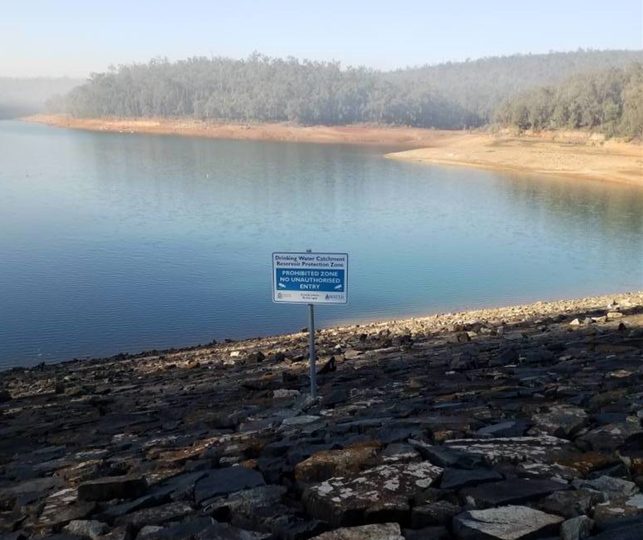Fishing remains prohibited at public drinking water dams during marron season

- Marroning not allowed at protected public drinking water source areas, even with a marron licence
- Fishing and other prohibited activities risk public drinking water quality
- Considerable fines and penalties for illegal fishing
Fishers are reminded that marron fishing remains prohibited at protected public dams and catchments during marron season, says Water Corporation, following a recent increase in illegal marroning.
To help keep drinking water supplies safe, marroning is prohibited all year round at protected public drinking water source areas, including for fishers holding a marron licence.
Over the last month, Water Corporation rangers have reported increased illegal fishing at public dams in the Perth metro area and South West, risking the drinking water catchment areas.
To prevent bacterial and chemical contamination, marroning, fishing and other water-based activities, such as swimming and canoeing, are only permitted outside protected public drinking water source areas.
Water Corporation General Manager Operations Barry Ford said access to the dams does not change during marron season.
“To help keep our drinking water safe, marroning is prohibited all year round at public drinking water dams and catchments with no exceptions during marron season, even if you hold a marron licence.
“Illegal fishing and other prohibited activities risk public health by exposing the catchments to bacteria and other pathogens, soil, litter and chemicals, such as spilled fuel.
“To protect our water supplies and the environment, offenders risk big fines and penalties for breaching rules.
“We thank the vast majority of Western Australians who do the right thing, helping us supply safe drinking water to the community.”
For further information on recreation within public drinking water source areas, visit here.
Members of the public who suspect illegal fishing can also help by reporting what they see to FishWatch on 1800 815 507. Reports are confidential.
ends/more
Media contact:
Media Team
P: (08) 9420 2555
E: media@watercorporation.com.au
Follow us on Twitter @watercorpwa
NOTE TO EDITORS
Community advice: keeping our public drinking water clean
You can help keep our drinking water safe and protect the environment by taking care in our public drinking water source areas:
To protect public health, you may only undertake water-based activities such as swimming, canoeing, marroning and fishing outside our public drinking water source areas
- When people have contact with water, bacteria and other pathogens can be transferred from their bodies into the water, without the person even knowing. This can put our drinking water supplies at risk because sometimes pathogens may survive simple disinfection.
Respect the reservoir protection zones
- Near a drinking water reservoir, the risk of bacteria and other pathogens, chemicals or soil particles entering the water is too high to allow public access. This area is called a reservoir protection zone, and usually extends two kilometres into a public drinking water source area from the high water mark of a reservoir.
- There are some exceptions to recreating in a reservoir protection zone, including travelling on public roads and the use of existing approved recreation facilities. For example, Mundaring Weir reservoir protection zone includes some existing walking tracks, including the Bibbulmun Track and the Golden Pipeline Heritage Trail. Similarly, the Munda Biddi and Carinyah bike trails are within the Canning River reservoir protection zone. The use of these historic walking tracks and cycling trails is allowed but please follow the guidance signs and stay on the paths.
- Reservoir protection zones are clearly signposted and scenic lookouts, picnic areas, walking tracks and cycling trails should be located outside these zones.
Stay on existing roads and tracks to prevent soil erosion and damage to wildlife habitat
- Off-road driving and cycling can damage vegetation and loosen soil. Soil can then be washed into streams with the next rains. This can put our drinking water at risk because soil particles floating in the water can reduce the effectiveness of the disinfectant used to kill bacteria and other pathogens in drinking water.
Camp only in designated campgrounds
- These are usually signposted in national parks, local parks, state forest or bush areas.
- When you have found a designated campground, camp within the existing cleared areas and use the toilet facilities provided to safeguard the environment.
Leave only footprints
- Take your rubbish with you or use the bins provided.
Signs in the catchment will show where pets are not allowed
- Pets can introduce bacteria and other pathogens into our public drinking water source areas and harm our native wildlife.
- Pets are allowed at Lane Poole Reserve, Whittaker’s Mill, Oakley Dam, Scarp Pool, Goldmine Hill, Binningup Beach and Wrights Bridge. If you are not sure whether dogs and/or other pets are allowed at the place you intend to visit, please leave them at home.
By protecting our public drinking water source areas and recreating in the designated places, you will help ensure the availability of safe, reliable, lower cost drinking water for now and into the future.
Source: Map of public drinking water source areas in Perth Hills and South West (Department of Water and Environmental Regulation)
ends/all